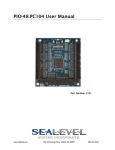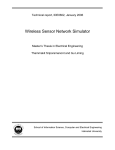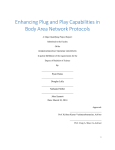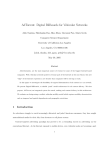Download RPI Graph and Statistics Package for ns User Manual and Tutorial
Transcript
RPI Graph and Statistics Package for ns User Manual and Tutorial David Harrison RPI CS Department∗ June 18, 2003 Abstract This user manual contains an installation guide and a short tutorial for the RPI graphing tools for ns. 1 Introduction The RPI graph and statistics package provides a set of classes for generating commonly used plots and gathering commonly important statistics. The graph package abstracts data collection from rendering. Each graph object instantiates a set of data collection objects which are attached to components in a network topology, as the simulation runs the data collection objects collect data often outputting the data to an intermediate file. After simulation, the graph object conforms the data to a canonical format and then sends it to a PlotDevice for rendering. By substituting plot devices, the user can cause the same graph to be output to a window or a file using gnuplot, fig, xgraph, xdvi, ghostview, or acroread. In Figure 1 we show a utilization graph that collects data from a link in an ns simulation and then outputs to a gnuplot plot device. The gnuplot plot device translates the data and commands from the utilization graph into gnuplot commands. The gnuplot application then generates an encapsulated postscript file. Other scenarios include rendering a graph with multiple plot devices for example to generate a postscript file while simultaneously displaying the data in an X window using xgraph. Or multiple graphs may be output to the same acroread plot device so that the graphs appear in a single acroread window in the given order. 2 Installation Presumably you already have the distribution and have installed ns-2. The graph package has been tested with ns-2.1.b5, ns-2.1b9a, and ns-2.26. There may be incompatibilities with other ns versions. If you have not downloaded the graph package then get it from http://www.ecse.rpi.edu/~harrisod/graph-v6.1.1.tar.gz. In order for the statistics and graphing packages to function, you must define two environment variables: the NS environment variable must point to the root of the ns source code tree, and the NSVER environment variable must contain the ns version number (e.g., ns-2.1b5 has version ∗ I am now in the EECS department at UC Berkeley and can be reached at [email protected]. 1 1 2 ByteCounter Simulation byte arrivals in last interval (x,y) values, plot title, axes labels postscript PlotDevice (x,y) values gnuplot commands gnuplot application Bottleneck Utilization vs Time 1 0.8 utilization UtilizationVersusTime encapsulated postscript = 0.6 0.4 sample interval=0.1s 0.2 0 0 0.5 1 1.5 2 2.5 3 time (seconds) 3.5 4 4.5 5 Figure 1: UtilizationVersusTime Graph outputting via gnuplot PlotDevice “2.1b5”). The following directions apply to ns version 2.1b5 and ns 2.1b7. Make a backup of your ns source code tree before attempting this installation. Before continuing make sure the following are in your search path: • nam, • acroread, • ghostview, • gnuplot, • latex, • pdflatex, • xdvi, • and xgraph. nam is necessary to run network animations. The remaining applications are used in the process of creating graphs. Not all of the applications are necessary to use the graph package though some PlotDevice classes will not function. See Table 2 for the list of PlotDevice classes and the dependencies between these classes and the applications. 1. If you have an earlier version of the graph package then remove it as follows, but only after backing up your ns source code tree. > cd $NS > rm -r rpi > rm -r tcl/rpi 2. Change to a temporary directory and then untar graph as follows: 2 > gunzip graph-v6.1.1.tar.gz > tar -xf graph-v6.1.1.tar > cd graph-v6.1.1 3. Move directories from the distribution into your $NS distribution. > cp -r rpi $NS > cp -r tcl/rpi $NS/tcl/rpi > cd $NS 4. Insert the following lines in your ns Makefile [...] INCLUDES= \ -I. -Irpi \ [...] OBJ_CC= \ [...] rpi/byte-counter.o rpi/delay-monitor.o rpi/file-tools.o \ rpi/rate-monitor.o rpi/rpi-flowmon.o rpi/rpi-queue-monitor.o \ [...] Here “INCLUDES= \” and “OBJ_CC= \” should already appear in your Makefile. “[...]” refers to an omission of lines already appearing in your Makefile. 5. Rebuild ns > > > > cd $NS rm gen/* make depend make 6. Test ns Change to the directory $NS/tcl/rpi/tests. Type run-test-suite.sh This will test the RPI Graphing and Statistics package. You should see the following output: ByteCounter Test: DelayMonitor Test: file-tools.tcl test: link-stats Tests: ... PASSED PASSED PASSED PASSED all 59 tests on the link-stats.tcl file. 3 After the text above, the test suite calls graph test/graph-test.tcl, which generates a set of graphs and displays them using a variety of plot devices. The suite first employs the “xdvi” PlotDevice that uses the postscript and latex PlotDevices to create graphs and descriptive text respectively. The “xdvi” PlotDevice then displays the generated DVI file using the “xdvi” application. Carefully inspect the generated plots for correctness against the plots bearing the label “Comparison Graph.” Because of the visual nature of the graphing tools and slight differences between versions of the various graphing applications, we found that the only reliable way to test the PlotDevice classes was through visual inspection. NOTE: That your output may not look exactly the same as the provided comparison graphs. Look for differences in content rather than small differences in presentation (e.g., ignore font differences). 4 3 Tutorial All of these examples assume a working knowledge of ns. If you have not created ns scripts before then consult the ns documentation and write a few test scripts before proceeding from here. Currently the graph package provides the graphs shown in table 1. Except for the XY class, an instance of any of these classes gathers statistics directly from an ns simulation and renders a plot when the instance’s plot member function (i.e., TCL instproc) is called. The XY class simply allows script writers to generate a plot from an arbitrary set of (x, y) coordinates. The XY class represents a way for a script writer to use the PlotDevice classes as a generic interface to a variety of output devices. CWndVersusTime FlowQLenVersusTime PointToPointDelayVersusTime QDelayVersusTime QLenVersusTime RateVersusTime REDQueueVersusTime RTTVarianceVersusTime RTTVersusTime Sequence SRTTVersusTime UtilizationVersusTime XY TCP congestion window size versus time sampled per-flow queue contribution versus time delay between two points on the network sampled queuing delay versus time sampled queue length versus time arrival rate versus time over constant interval length avg queue, instant queue versus time TCP variance in round-trip-time versus time TCP round-trip time versus time TCP sequence number versus time TCP smoothed round-trip time versus time utilization versus time over constant interval length plot (x, y) coordinates from an input file Table 1: Provided Graph classes 3.1 Example 1: Graphing link statistics To include the graph package we preface every experiment script with the following: source $env(NS)/tcl/rpi/graph.tcl The graph package contains several graphs for gathering statistics about traffic passing through a link including queue length versus time, utilization versus time, rate versus time, and queue delay versus time. In this example we will show how to graph utilization over given fixed intervals versus time. Assume we have created a topology with a known bottleneck spanning ns nodes n0 and n1. Next we add the lines shown in figure 2 to our script. To collect statistics for our graph we instantiate a Graph/UtilizationVersusTime object. The arguments $n0 and $n1 tell the graph object to collect statistics for the link spanning between nodes n0 and n1. The 0.1 argument tells the graph object that it should measure utilization over 0.1 second intervals. When the simulation finishes, we call $util_graph display to tell the graph object to show a window containing our utilization versus time plot generated using gnuplot. We show the complete source code for this script in graph-v6.1.1/examples/ex1.tcl, and the generated graph in figure 3. 5 ' $ [...] proc finish {} { global util_graph [...] $util_graph display exit 0 } [...] ;# define nodes n0 and n1 and link spanning them. # create graph of utilization vs time for link [n0,n1]. set util_graph [new Graph/UtilizationVersusTime $n0 $n1 0.1] & % Figure 2: Utilization versus time script: ex1.tcl Bottleneck Utilization vs Time 1 utilization 0.8 0.6 0.4 sample interval=0.1s 0.2 0 0 0.5 1 1.5 2 2.5 3 time (seconds) 3.5 4 4.5 5 Figure 3: Graph generated by ex1.tcl 3.2 Example 2: Outputting to Various Plot Devices The graph package can output graphs to windows or files using various applications or formats for displaying/saving graphs. We show the current set of supported “plot devices” in table 2. In graph-v6.1.1/examples/ex2.tcl we provide an example script that uses an xdvi plot device to display multiple graphs in the same window in the designated order. One of the first things we do in this script is to create a plot device: Graph set plot_device_ [new xdvi] Here we create an instance of the xdvi class and assign it to the Graph plot_device_ class member. Whenever a graph object is instantiated it by default uses the plot device defined in the 6 acroread fig ghostview gnuplot gnuplot35 latex pdf postscript postscript35 xdvi xgraph When closed, display all graphs plotted with this device using acroread. Uses postscript PlotDevice and the pdflatex application. Output to fig file via gnuplot. Output eps via gnuplot then display using ghostview Show plot in X window using gnuplot. Show plot in X window using gnuplot 3.5 (no comments). Output to eps file using the postscript PlotDevice and run latex to create a latex file that includes the graphs. Output to pdf file from eps using epstopdf. Output to encapsulated postscript via gnuplot. Output to eps via gnuplot 3.5 (no comments). When closed, display all graphs plotted with this device using xdvi. Show plot in X window using xgraph. Table 2: Supported plot devices Graph plot_device_ class member. All of the classes can be instantiated by passing a plot device object to their respective init instprocs. This allows you to use a different plot device for each graph object if you so wish. We show the relevant snippets from the ex2.tcl script in figure 4. Not shown in figure 4 we create a topology containing a bottleneck between nodes $n0 and $n1. We then define two TCP connections that pass through the bottleneck. The first of these two connections has the TCP agent object $tcp0. Shown in figure 4, we create three graph objects of which the first two install statistics gathering objects into the bottleneck link from n0 to n1. The last graph object traces the congestion window of tcp0. When the simulation completes we output each of the graphs to encapsulated postscript by calling each object’s display instproc. Next we close the plot device causing the plot device to compile a latex file that references the eps files generated by each graph object. The latex compiler outputs an dvi file which the plot device then opens using xdvi. 3.3 Example 3: Outputting Graphs as Files Often we want to generate graphs as files for inclusion in a report or paper. In the previous example we showed how to output into xdvi. In this example we consider outputting to a fig file for later annotation using xfig. With this example we also take into consideration where generated files are placed in the file system. We show code snippets for Example 3 in Figure 5. Example 3 differs from Example 2 only in that we use a different plot device, in this case fig, and we explicitly tell util_graph to output to the file named bneck_util_vs_time in the current working directory. Note that this is not the exact filename of the output file. The plot device appends an id unique to the plot device and then appends a file type extension. The actual output file’s name is bneck_util_vs_time_0.fig . Note that setting output_filename_ does not affect the location of any trace or other temporary 7 ' $ [...] Graph set plot_device_ [new xdvi] [...] proc finish {} { global util_graph qlen_graph cwnd0_graph $util_graph display $qlen_graph display $cwnd0_graph display [Graph set plot_device_] close run-nam exit 0 } [...] ;# define a bottleneck between n0 and n1. set util_graph [new Graph/UtilizationVersusTime $n0 $n1 0.1] $util_graph set title_ "Bottleneck Utilization vs Time" set qlen_graph [new Graph/QLenVersusTime $n0 $n1] $qlen_graph set title_ "Bottleneck Queue Length Versus Time" set cwnd0_graph [new Graph/CWndVersusTime $tcp0] $cwnd0_graph set title_ "cwnd of flow 0 versus Time" [...] & % Figure 4: Example 2: Display multiple graphs using xdvi files. All temporary files are by default written to a temporary directory located in /tmp/expx where x is replaced with smallest integer that has not already been used in the naming of another exp directory in /tmp. The user can change the default directory by setting tmp_directory_ global variable before instantiating any Graph objects. However, this is only advisable if the user is sure that the directory used to store temporary files resides on the same machine that is executing the script, since writing across a network will not only slow down the simulation but may adversely affect other users sharing the network. If the user does not set the output_filename_ data member then the output file is placed in tmp_directory_ with a default name specific to the Graph class. 3.4 Example 4: Multiple Plot Devices Note that the caller can output the same graph object to both a file and a window by using two plot devices. In ex4.tcl we use xfig and postscript to generate encapsulated postscript while displaying the graph using xfig. We show the relevant code snippet in Figure 6. Notice that we do not call 8 $ ' [...] Graph set plot_device_ [new fig] [...] set util_graph [new Graph/UtilizationVersusTime $n0 $n1 0.1] $util_graph set title_ "Bottleneck Utilization vs Time" $util_graph set output_filename_ "bneck_util_vs_time" [...] & % Figure 5: Example 3: Outputting Graphs to Files the “display” instance procedure on the graph object. The “display” method plot using the default PlotDevice. We have not defined a default plot device in this script. Instead we pass the graph directly to two different plot devices. Note that often times there is little need for more than one plot device since plot devices create intermediate files of the desired type (e.g., xdvi creates encapsulated postscript files for each graph). Multiple plot devices is more useful when the desired file type is not generated as an intermediate file when displaying the graph in a window as in ex4.tcl. ' $ [...] proc finish {} { [...] set xgraph_plotter [new xgraph] set eps_plotter [new postscript] $xgraph_plotter plot $util_graph $eps_plotter plot $util_graph $xgraph_plotter close $eps_plotter close [...] } [...] set util_graph [new Graph/UtilizationVersusTime $n0 $n1 0.1] $util_graph set title_ "Bottleneck Utilization vs Time" $util_graph set output_filename_ "bneck_util_vs_time" [...] & % Figure 6: Example 4: Output to a file and to an X window using xgraph 3.5 Example 5: Bottleneck link statistics We now move on to demonstrating how to collect statistics using the statistics functions included with the graph package. The objective of these statistics gathering tools is to simplify statistics 9 gathering over the standard methods provided by ns. To include the link statistics gathering functions do the following: source $env(NS)/tcl/rpi/link-stats.tcl To begin gathering statistics on a link spanning from nodes n0 to n1, do the following: set stats [new LinkStats $n0 $n1] We show code snippets from examples/ex5.tcl in figure 7. The calls to get-utilization, get-mean-queue-delay, and get-packet-arrivals returns the link statistics gathered from the moment the link-stats object was instantiated. In this case, that means reporting statistics gathered from the beginning of the simulation. There are many more statistics we could report by simply calling any of the instance procedures in table 4. ' $ [...] proc finish {} { global n0 n1 tcp0 tcp1 stats # output link statistics puts "Bottleneck statistics: " puts "Utilization: [$stats get-utilization]" puts "Number of drops: [$stats get-packet-drops]" puts "Mean queue delay [$stats get-mean-queue-delay]" puts "Number of arrivals [$stats get-packet-arrivals]" [...] } [...] ;# create topology w/ bottleneck between n0 and n1. set stats [new LinkStats $n0 $n1] [...] & % Figure 7: Example 5: Gathering link statistics If you wish to gather statistics starting from some time into the simulation then simply instantiate the LinkStats object at that time. If you want to gather statistics over consecutive time intervals then you can reset the link statistics at the end of each time interval by calling the LinkStats reset instance procedure. If you want to collect a link’s statistics for overlapping intervals then create two LinkStats objects each at a time when you want to begin collecting statistics then retrieve the statistics at the end of their respective intervals. Installing more than one LinkStats object on a link is particularly useful when you want to record statistics for the whole simulation as well as for the steady-state (i.e., skipping some time to eliminate initial transients). We provide the code for this complete example in graph-v6.1.1/examples/ex4.tcl. 10 init n0 n1 [qmon] Instantiates a LinkStats object spanning between n0 and n1. You must have previously created these two nodes and a link spanning these nodes. More than one LinkStats object can span between n0 and n1. By default the LinkStats object uses an instance of the RPIQueueMonitor class to collect statistics. You can install your own queue monitor using the optional third argument. reset resets all statistics to the initial state. Table 3: Special instance procedures for LinkStats 11 get-utilization Returns the link utilization as the number of bytes departing the queue as the number of bytes that could have departed the queue. get-packet-utilization avgpktsz Returns the link utilization as the number of packets that departed the bottleneck link times the average packet size over the number of average sized packets that could have departed the link. The argument specifies the average packet size. get-throughput Returns the number of byte arrivals at the tail of the queue * 8 over time. get-packet-arrivals Returns the number of packet arrivals at the tail of the queue. get-byte-arrivals Returns the number of byte arrivals at the tail of the queue. get-packet-drops Returns the number of packets dropped. get-byte-drops Returns the number of bytes dropped. get-packet-departures Returns the number of packets that departed the queue. get-byte-departures Returns the number of bytes that departed the queue. get-mean-queue-delay Returns the mean delay experienced by packets transiting the queue. get-queue-delay-variance Returns the variance in delay experienced by packets transiting the queue. get-queue-delay-stddev Returns the standard deviation in delay experienced by packets transiting the queue. get-mean-packet-queue-length get-mean-byte-queue-length Returns the mean packet queue length. This is not the same as the mean queue length seen by an arriving packet which would not take into account idle times in the mean. Same as get-mean-packet-queue-length except the result is returned in units of bytes. get-max-packet-queue-length Returns the maximum queue length in packets. get-max-byte-queue-length Returns the maximum queue length in bytes. get-min-packet-queue-length get-min-byte-queue-length Returns the minimum queue length in bytes. Typically this would be zero except when measured over some small interval. Same as get-min-byte-queue-length except the result is returned in units of bytes. Table 4: LinkStats statistics instance procedures 12 3.6 Example 5: TCP statistics The most direct way to obtain TCP statistics is to simply query the bound variables defined for the Agent/TCP class. For example, if we define a TCP agent $tcp0 then we can do the following without extending ns-2: puts "Number of data packets transmitted by flow 0: \ [$tcp0 set ndatapack_]" puts "Number of data packets transmitted by flow 1: \ [$tcp1 set ndatapack_]" puts "Retransmission timeouts for flow 0: \ [$tcp0 set nrexmit_]" puts "Retransmission timeout for flow 1: \ [$tcp1 set nrexmit_]" When using our TCP statistics gathering functions it is necessary to include the tcp-stats.tcl package. This loads the definitions shown in tables 5 and 6: source $env(NS)/tcl/rpi/tcp-stats.tcl Then initialize various counters by calling init-stats. init-stats can also be called to simply reset the the statistics for both our extensions and the statistics gathered by ns-2.1b5. [...] $tcp init-stats [...] At some later time, such as when finish is called, you can output tcp-statistics as follows: puts "Goodput Variance: \ [get-goodput-stddev "$tcp0 $tcp1"]" puts "Total TCP packets: \ [get-total-data-packets "$tcp0 $tcp1"]" In the example above, get-goodput-stddev and get-total-data-packets operate on a list of tcp agents. In this case returning the standard deviation in goodput and the sum of the data packets sent respectively across the passed list of agents. The above examples can be found in examples/ex6.tcl. 4 Performance Issues When one is running large or long simulations, there are various considerations to take into account with respect to the tools used for gathering statistics or generating statistics. Our tools have been defined to introduce reasonable overhead, though in some cases simulation performance constraints may drive one to design task-specific tools. We outline some of the performance considerations in this section. 13 get-useful-packets get-useful-bytes Returns the number of packets transmitted containing new data. Returns the number of bytes transmitted containing new data. The number of useful bytes in each useful packet is the packet size minus the TCP and IP headers. The header size is determined by tcpip_base_hdr_size_ defined in $NS/tcl/lib/ns-default.tcl. In ns-2.1b5, tcpip_base_hdr_size_ is set to 40. get-goodput-bps Returns the rate of useful bits transmitted by the network. Uses get-useful-bytes to determine the total number of useful bits. Packets that have been lost but not yet detected by the source are counted as useful because our measure is based on state maintained by the TCP source. In a long simulation this should have negligible impact on the goodput measure. get-goodput Returns goodput in bps over the bottleneck capacity. Table 5: TCP statistics gathering instance procs 4.1 When to Use NAM, Graph, and Stats nam tracing is best used to generate animations. For any simulation containing more than a handful of nodes, containing bottlenecks with large bandwidths (> 10 Mbps), and/or running more than a couple of seconds, nam tracing will probably be too slow. nam is slow because in order to generate network animations ns outputs to a trace file every time a packet enters, departs, or is dropped from any queue in the simulated network. Simply turning nam tracing off often reduces simulation run times by an order of magnitude. In particular, if you are parsing nam traces to generate statistics then perhaps you should consider using some other tool. Graph objects sit on a single link or deal with a single TCP agent. Unless the user wants to generate graphs for every link in the simulated network, installing Graph objects will probably yield significantly less overhead in terms of simulation run time and disk space consumption than generating graphs by post-processing nam traces. Of course, the Graph objects are best used for generating graphs, any other use of the Graph classes or their respective intermediate files is suspect. The Graph objects generate trace files (though substantially smaller than nam traces), and useful statistics might be derived from these traces. However, if you only want to determine a single statistic across the length of a simulation then the functions found in link-stats.tcl or tcp-stats.tcl are probably better for the job. The link-stats.tcl and tcp-stats.tcl functions generate far less overhead than either nam or the Graph classes, simply because none of the link-stats.tcl or tcp-stats.tcl generate trace or other intermediate files. Instead the LinkStats object installs counters in the link being monitored. Incrementing a counter introduces far less overhead than outputting to a file. When the user later requests the statistic, the corresponding components are then queried. However, the LinkStats object installs objects for measuring a large array of link statistics. Sometimes this means installing unnecessary counters or similar objects into the links being monitored. For example, the LinkStats object installs objects at the tail and head of the link’s queue. Placing an object at the queue’s head is unnecessary if the script writer only wants to know the number of 14 get-mean-goodput tcplist Calculates mean goodput in bps across the passed TCP agents (i.e., connections). get-goodput-variance tcplist Calculates variance in goodput (bps) across the passed TCP agents (i.e., connections). get-goodput-stddev tcplist Calculates the standard deviation in goodput in bps across the passed TCP agents (i.e., connections). Calculates the Coefficient of Variation (C.O.V.) across the passed TCP agents. C.O.V. is standard deviation over the mean. Calculates the sum of the packets sent across the passed TCP agents (i.e., connections). get-goodput-cov tcplist get-total-data-packets tcplist get-total-retransmitted-packets tcplist Calculates the sum of the packet retransmissions across the passed TCP agents (i.e., connections). get-total-retransmission-timeouts tcplist Calculates the sum of the retransmission timeouts across the passed TCP agents (i.e., connections). Table 6: TCP statistics functions operating on lists bytes that arrived at the head of the queue. Usually the few extra objects represents negligible overhead. However, if the script writer has particularly tight performance constraints then the script writer will have to write his or her own objects designed specifically to gather the desired statistics. 5 Other Performance Issues with Graphs There are two other important performance issues with regard to the graph classes: 1) where to output files, and 2) using averaging intervals. The cost of outputting to one file is not necessarily the same as the cost of outputting to another file. The disparity is particularly large between local and remotely mounted files. A trace file should probably never be placed on a volume mounted across a network, because each write may generate a packet. Consider for nam that this would mean generating a packet on the real network for every packet arrival, departure, or drop in the simulated network. A single NAM simulation can easily swamp a file server while simultaneously drastically slowing down simulation run times. Instead, trace and other intermediate files are usually output to a temporary directory. In UNIX, /tmp resides on a workstation’s local hard drive; therefore, that is why the Graph package by default places all intermediate as well as output files in /tmp (see Example 3). Now this brings us to the second important performance issue: averaging. Several of the Graph classes allow the user to specify whether to output instantaneous or time averaged values. For example, QLenVersusTime’s third argument to its init instproc (i.e., its constructor) is sample_interval. By default, the sample interval is set to -1 denoting that QLenVersusTime 15 should record the queue length at every arrival and departure of a packet. This results in particularly large generated files and slow run times, but it also allows the user to easily see transient queuing behavior. If the user wishes to improve simulation run times or reduce the size of trace files, the user can set sample_interval to a positive value denoting the time interval over which the queue length is averaged. At the end of each interval, the average is output to the graph’s trace file. Larger averaging intervals result in shorter run times at the expense of generating graphs with smoother output (i.e., less transient behavior is revealed). 6 LinkStats and TCP Stats and Long Run Times When simulations are run for long times or when bottleneck bandwidths are high, it is quite possible that certain signed long integers (32-bit) will overrun causing erroneous results from LinkStats objects. To fix this problem the user should perform some worst-case analysis of the number of bytes or packets that will pass through a link before running a simulation. We specifically mention “bytes” because byte counters tend to increment much faster than any other counters in a simulation. To avoid overruns, the simulation script must periodically reset the corresponding counters by calling LinkStats’ reset member function (i.e., TCL instproc) or TCP’s init-stats member function depending on the statistic that is in danger of an overrun. The simulation script can then either store the intermediate values of the statistic for later post-processing or only rely on the final value. 16



























